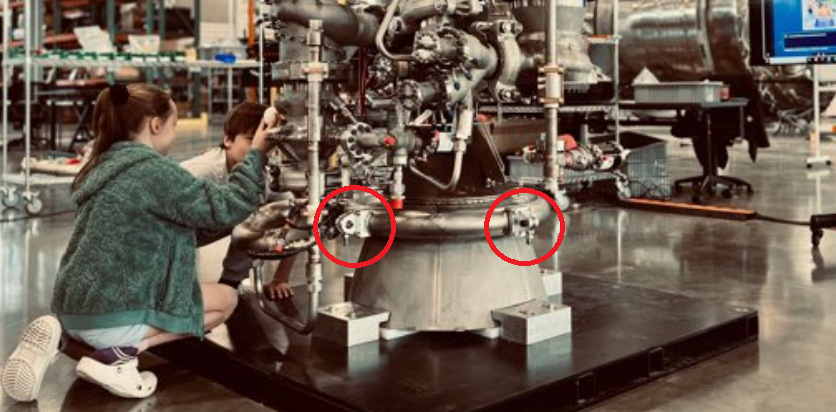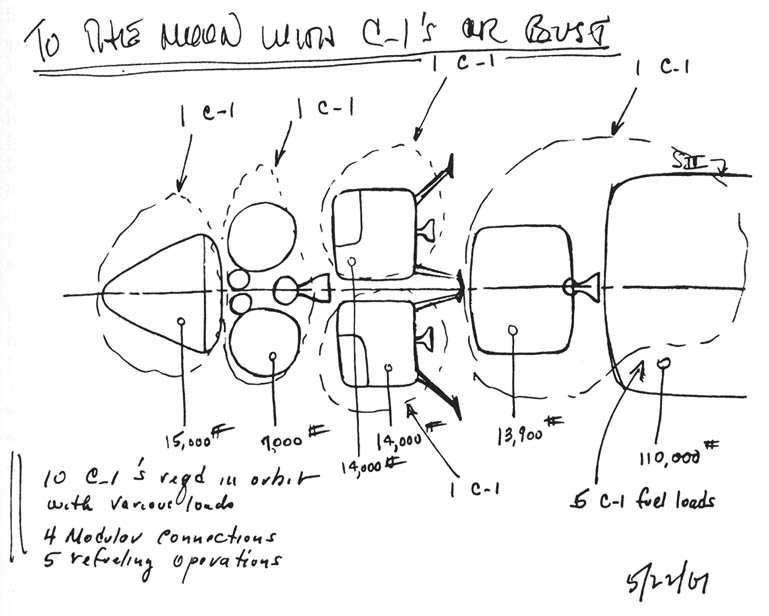-
Posts
8,925 -
Joined
-
Last visited
Content Type
Profiles
Forums
Developer Articles
KSP2 Release Notes
Bug Reports
Posts posted by sevenperforce
-
-
On 4/8/2024 at 2:30 PM, Exoscientist said:
If they intend to use version V2 then this is bad because it would require further qualification flights for the larger version and
Given that they have not started any qualification flights, this does not appear to be a problem, now does it?
-
Just now, JoeSchmuckatelli said:
I was excited to see these - unfortunately they're not showing up
They didn't show up for me either, but if you right-click the image and hit "open in new tab" then they are visible.
-
13 hours ago, Superfluous J said:
At a winery? If so I may have been standing nearby

Nope, but it sounds like other people had a similar idea! This was at a public park in Terre Haute, IN.
My Tiktok livestream of the ceremony caught this shot of the moonshadow whooshing overhead at the end of totality. Try to pay attention to the sky rather than the sun and you can see it:

The setting and ceremony was really beautiful, and we had a great time.




We catered our own wedding so I did eclipse tarts that all show varying levels of partiality:


Some video of the eclipse etc:
https://www.tiktok.com/t/ZPRTnu1Yd/
https://www.tiktok.com/t/ZPRTn3QRd/
-
21 minutes ago, NFUN said:
those by definition have no event horizons...
I meant naked in the sense of having no accretion disk, not in the sense of a naked singularity.
In any event: I am blown away. Unable to really express it. It’s the most amazing thing I’ve ever seen, by far. Doubly amazing because we were getting married during it.
-
18 hours ago, Kerb24 said:
I cannot put into words how amazing that was. My mind is still struggling to process it.
It was what you would imagine it would look like to be a god staring into the event horizon of a naked black hole.
-
On 3/25/2024 at 4:47 PM, cubinator said:
Now THAT's a diamond ring to remember!
Speaking of rings, we forged our own wedding bands from a 125-year-old gold coin (with additional space themes as expected):
https://www.tiktok.com/t/ZPRTqKkke/
(if you feel like helping us celebrate at all, we’ve got a honeymoon fund here.)
-
Radian has an update:
Wow! They have finally gotten enough capital to pay for a NEW RENDER!
-
11 hours ago, tater said:
That's gorgeous to see!
It's very curious to me that neither turbopump is being placed inline with the engine. An inline approach (Raptor, BE-4, RD-191) would seem like the simpler, more lightweight design. Granted, other single-chamber engines with dual-shaft (separate turbines) turbopumps (RS-25, RS-68, YF-100, Vulcain, YF-20, YF-77) have both turbopumps off-axis, but that feels like it has almost always been due to other design constraints. Maybe it's an engine length issue? Something to do with how they are handling gimbal?
I wonder if the gimbal is happening halfway down the nozzle rather than up at the top. The structure of the top of the engine looks pretty gimbal-unfriendly, and these highlighted bits around the nozzle extension look suspiciously like gimbal mounts:

(Notable that those are clearly Lapsa's kids which is just awesome.)
Putting the gimbal halfway down the engine bell is....definitely different. Probably lower control authority, among other things. But I suppose it could really reduce weight in other places.
-
15 hours ago, Exoscientist said:
He has an obvious error at item 4 -- "orbital" velocity. There is no indication whatsoever that Starship failed to reach its intended velocity or trajectory.
That is a debatable point because Elon did say there was an 80% chance of the Starship reaching orbit on this flight:
There was a 0% chance of Starship reaching true orbit because that was not the design trajectory. If Starship had reached true orbit, then something had to go very, very wrong. So obviously Elon was not talking about true orbit; he was saying that there was an 80% chance of Starship making it successfully through staging and the full-duration second-stage burn to its intended SECO.
Otherwise you're saying that when Elon says "80% chance" he is actually saying that the mission only has a 20% chance of success.
15 hours ago, Exoscientist said:But there still remains the question of why didn’t IFT-3 reach orbital velocity? In the case of IFT-2 they vented LOX reducing the velocity it was capable of, and Elon even said if they had a payload and had not vented LOX they would have reached orbit.
But they didn’t vent LOX on IFT-3 and SpaceX said they had a full propellant load and from the view of the propellant gauges the propellant was virtually expended in both stages. So why were they not able to reach orbit even though carrying 0 payload?
I've already painstakingly explained this to you. The very sentence where SpaceX says they had a "full propellant load" they also state the total amount of propellant and it is significantly lower than the actual full capability of Starship, meaning that it was a "full propellant load for this mission" not a "full propellant load for the maximum design capacity".
Or would you argue that the BE-4 engines on the Vulcan Cert-1 mission must have been operating at above their stated thrust levels because Vulcan reached "full propellant load" and an actual full propellant load is too heavy for two BE-4s to lift? (Obviously not; Bruno specifically said that they underfilled the tanks, just like SpaceX specifically quoted a total propellant amount lower than the maximum design capacity).
And even if they HAD a "full propellant load" (which they did not), that doesn't mean they would have accidentally entered a true orbit. Burning for a high apogee achieves orbital velocity without fully circularizing. You've played KSP, right? Haven't you ever accidentally burned too early or burned at the wrong angle and ended up depleting your props with a high apogee before you finish circularizing? Plus, burning at lower throttle can achieve the same thing. They were targeting a specific re-entry zone for a reason.
8 hours ago, Exoscientist said:I’ve suggested that SpaceX intentionally ran the Raptors on IFT-2 and IFT-3 at reduced power, i.e., thrust, to improve reliability.
Even if there was evidence that the Raptors were run at reduced power during IFT-2 or IFT-3, this wouldn't necessarily imply a reliability issue; it can also be done to achieve a full-duration burn time with a decreased propellant load in order to avoid entering a true orbit.
You know, the thing that they explicitly said they were doing.
-
On 3/30/2024 at 4:35 PM, tater said:
Instead of trying to launch 3 rockets within <4.5 hours, they should do the prudent industry thing and spread these 3 launches over at least one Quarter. This just isn't "how it's done."
Departing from industry standard. Tsk tsk. And they expect to get government contracts?!
-
1 hour ago, Exoscientist said:
Common Sense Skeptic, a well-known critic of SpaceX presents an argument that considering all the mission objectives IFT-3 should not be regarded as a successful test:
Appreciated a short synopsis. There's no way I was listening to a whole big post.
With respect to the booster engine landing burn relight: once grid fin control was lost, the booster return was expected to be a failure. If you'll recall, the CRS-16 mission suffered a similar fate when one of its grid fins entered a hydraulic stall and stuck hard-over. There, the single engine tried valiantly to correct for the problem, but it was already off-nominal. This is the same situation. Engine relight depends on a number of factors, including vehicle stability, and so once you are spinning out of control you don't expect engine relight to work.
He has an obvious error at item 4 -- "orbital" velocity. There is no indication whatsoever that Starship failed to reach its intended velocity or trajectory.
He then says that the payload door demo was not successful because the vehicle started to spin once the payload bay vented to space. That doesn't make any sense. It's clear that Starship lost attitude authority (likely due to frozen propulsive vents); whether or not it lost attitude authority doesn't impact the success of the payload door demo. He subsequently says "we have no indication that the test took place" and claims that this is because we did not see any graphical change in the LOX levels, which is also nonsensical; there was no indication that the GUI was supposed to show this. This should be a questionmark, not a failure.
Finally, he claims that because the re-entry time was three minutes different from the estimate from some random person on the internet, this meant it did not re-enter where it was supposed to re-enter. I shouldn't have to explain how silly THAT is.
-
19 hours ago, farmerben said:
I just tested with 50 TWR vessel on Minimus. Going straight up uses 248 dV to escape the SOI. Changing to a near horizontal trajectory and burning in a straight line uses almost the same amount of dV.
However, throttling down and taking a gradual spiral used 279 dV.
Once you are past escape velocity, you no longer need to worry about gravity turns. Minmus has such low gravity that with substantial T/W you can achieve escape velocity within the first few seconds of launch, obviating the need for a gravity turn.
Note here that you are still achieving an orbit; it's just an orbit with a periapsis under the surface of Minmus.
-
3 minutes ago, zolotiyeruki said:5 hours ago, Exoscientist said:
SpaceX repeating the same mistakes over and over again does not make those mistakes correct.
Just to be clear, what "mistake" is SpaceX repeating over and over again?
Not monitoring this forum more closely and therefore missing exo's advice, apparently.
-
13 minutes ago, Ultimate Steve said:
Hmm, looks like they did. Memory is a weird thing.
The RVacs are designed to have flow separation just barely starting around the very edge of the nozzle at sea level. The nozzle is reinforced at the edge which helps keeps this from causing issues. Part of this was to save weight, part of this was to make them easier to static fire at sea level.
-
I will be getting married in Terre Haute, Indiana during the eclipse.
-
I'm so very excited to see what they've come up with.
-
1 hour ago, .50calBMG said:
Just because they said fully fueled doesn't mean 100% full. There's plenty of rockets that will partially fuel the tanks for certain variants or flight profiles. Fully fueled in this case could just mean "fully fueled for this mission profile"
Yep, that's precisely what they meant.
Superheavy takes 3,400 tonnes of propellant while Starship takes 1,200 tonnes of propellant. Fully loaded, that would be a total of 4,600 tonnes of propellant. Yet SpaceX said "fully loaded with more than 4500 metric tons of propellant"; we can therefore pretty readily deduce that "fully fuelled for this mission profile" meant 100 tonnes LESS propellant in Starship than in an orbital mission profile.
-
On 3/22/2024 at 4:32 PM, kerbiloid said:
First Luna crafts were sent (in)to the Moon without intermediate LEO.
https://en.wikipedia.org/wiki/Luna_1"Without intermediate LEO" doesn't mean that the rocket was launched vertically straight up all the way to the moon. The Luna 8K72 three-stage rocket (2.5 stages by US accounting) still executed a normal gravity turn, etc.; it just didn't stop off in a parking orbit. The Blok E upper stage burned continuously from stage separation all the way through to translunar injection. The RD-0109 engine most likely used a pyrotechnic igniter like the RD-0110 that came after it, so it was not designed to be restarted for that mission, requiring a single continuous burn.
You never burn straight up all the way.
On 3/22/2024 at 4:32 PM, farmerben said:If you have TWR of 1.5 or so, then the vertical approach is way less efficient. With TWR greater than 3 the amount wasted is very small.
With T/W ratio of more than 3, you begin losing substantial amounts of Δv to aerodynamic drag. I don't believe there is any situation where thrust to weight balance makes a vertical launch more efficient. You're not really "losing" anything at all by entering a stable orbit first, except perhaps a very tiny amount of Oberth advantage.
On 3/23/2024 at 8:30 AM, darthgently said:the DV req'd for that horizontal velocity isn't free either and keeps you in the atmo longer
This is the wrong way of thinking about it. While the Δv required for horizontal velocity isn't free, it's not wasted, either. The Δv you spend getting to orbit is preserved as your orbital velocity, which is then added to your eventual injection burn.
The only thing that is "wasted" is thrust spend pointing at the ground, resisting gravity.
Gravity turns are designed specifically to start the pitchover such that drag will be minimized. MaxQ happens very early in flight; drag after MaxQ is negligible. So "keeps you in the atmo longer" is not an issue.
On 3/23/2024 at 9:23 AM, farmerben said:The inclination difference is no big deal. It's easy to adjust inclination after leaving the atmosphere.
Not really, no. You want to change your inclination while moving at the lowest possible velocity. When you choose a particular launch direction, you are picking your inclination at a velocity of zero, which is optimal.
Burning out of the atmosphere and then changing directions is a huge waste of Δv.
On 3/23/2024 at 9:23 AM, farmerben said:Nobody claimed the vertical approach would save dV. But if the difference is not significant, what advantages does it have?
The difference is significant.
On 3/23/2024 at 9:23 AM, farmerben said:One of the big advantages in game is you can have oversized payloads without a fairing. The aerodynamics hurt you less.
If you are going fast enough to make up for the gravity drag losses, you will run into aerodynamics issues much sooner.
-
5 hours ago, darthgently said:
I'm already hearing in my mind the argument that going straight up means you are "fighting directly against gravity longer", but if your goal is solar orbit I'm not sure fuel spent going orbital around the launch body isn't just as wasteful.
It's not wasted, though. Your orbital speed contributes to your ejection burn -- that's why you can't just burn for solar orbit anywhere; you have to burn at the point where your orbital velocity vector lines up with the ejection burn direction.
Burning straight up on Kerbin is doable in part because of Kerbin's high density. Kerbin has the same gravity as Earth but is physically much smaller, meaning that Fg = GMm/r2 (that's the equation for gravity) falls off rapidly as you climb. If you were to burn straight up off of Earth's surface, the gravitational attraction only would be reduced by a few percent by the time you got to space; on Kerbin it is substantially lower even while you're still in the atmosphere.
There's virtually no delta-v wasted by going into a stable orbit first before you start your ejection burn.
-
11 hours ago, mikegarrison said:
I've been hearing that about fusion power for the past 45 years.
People say that (incorrectly) about sustainable fusion power, sure, but this is about an unsustainable pulsed Z-Pinch fusion propulsion. That's a much easier problem. If we had the political will to build it, we could do it without any major issues or new physics.
-
11 hours ago, DAL59 said:
I know this would be impractical, but could you do a Direct Ascent profile with a fully expended V3 Starship, a third stage with landing legs as its payload, with an Orion capsule on top?
Over on the SpaceX thread, @tater estimated that a fully-expended V3 Starship could throw 145 tonnes to TLI. We already know that Orion can make it back from LLO on its own (that's how Constellation was designed). So we need a third stage to get us from TLI to the surface of the moon and back up to LLO.
Going from TLI to LLO costs 900 m/s; going from LLO to the lunar surface costs 1,870 m/s each way. So you need 4,640 m/s on that third stage. Orion has a loaded mass of 26.5 tonnes and a single vacuum Raptor comes in at around 1.8 tonnes. Let's round up to 2 tonnes to account for the gimbal system and so forth. At a notional 375 s of specific impulse, you'll need at least 72.5 tonnes of methalox to achieve 4.64 km/s, not counting tanks and so forth. That brings the total TLI throw to 101 tonnes, not counting tank weight and landing leg weight and egress system weight and other payloads, or the added props to get all of that along for the ride.
Absolutely doable.
-
1 hour ago, darthgently said:
I'm picturing sweaty space sailors in the ring-capacitor magazine ramming ring-capacitor rounds into the chamber and locking the bolts closed like WWII 88 loaders now
They would be sweaty all right. The neutron radiation dose in proximity to an operating D-D fusion generator becomes lethal after approximately one fifth of a second.
-
Just a funny for today:

There are so many different possible mission configurations. I think I attempted to make a comprehensive list once, probably upthread in this same thread.
- Double Direct Ascent. One rocket flies from the surface of Earth to LEO to lunar orbit to the surface of the moon, then back to lunar orbit and thence to the surface of Earth. Nova C-8 and Tintin designs.
- Earth Orbit Rendezvous with Lunar Direct Ascent. Multiple rockets fly from the surface of Earth to LEO, assemble into one big rocket in LEO, fly to lunar orbit and to the surface of the moon, then back to lunar orbit and thence to the surface of Earth. This was the "C-1s or Bust" design and is also similar to some Lunar Starship concepts (though not HLS).
- Single-Launch Lunar Orbit Rendezvous. One rocket flies from the surface of Earth to LEO to lunar orbit, then part of it stays in lunar orbit while another part completes the lunar landing and ascent back to lunar orbit and rendezvous, then the first part comes back to the surface of Earth. Apollo design.
- Synchronous Double Orbital Rendezvous. Multiple rockets fly from the surface of Earth to LEO, assemble into one big rocket in LEO, fly to lunar orbit, then part of it stays in lunar orbit while another part completes the lunar landing and ascent back to lunar orbit and rendezvous, then the first part comes back to the surface of Earth. Constellation design.
- Asynchronous Lunar Orbit Rendezvous. Multiple rockets fly from the surface of Earth to LEO to lunar orbit, then assemble into one big rocket in lunar orbit, then part of it stays in lunar orbit while another part completes the lunar landing and ascent back to lunar orbit and rendezvous, then the first part comes back to the surface of Earth. Artemis design with Blue Origin HLS.
- Asynchronous Double Orbital Rendezvous. Multiple rockets fly from the surface of Earth to LEO which may or may not assemble into big rockets in LEO, fly independently to lunar orbit, then assemble together in lunar orbit, then part of it stays in lunar orbit while another part completes the lunar landing and ascent back to lunar orbit and rendezvous, then the first part comes back to the surface of Earth. Artemis design with Starship HLS.
- Asynchronous Lunar Direct Ascent. Multiple rockets fly from the surface of Earth to LEO to lunar orbit, then assemble into one big rocket in lunar orbit, then lands on the surface of the moon, then comes back to lunar orbit and thence to the surface of Earth. Nobody has seriously proposed this but it is kinda like some Lunar Starship concepts with cislunar refueling.
Did I miss anything?
I will note that the graphic is incorrect in one regard: the Earth Orbit Rendezvous would have required multiple Saturn 1Bs per landing, not multiple Saturn Vs:

The "C-1" was the Saturn 1B.
-
The name of it isn't coming to me at the moment, but I believe there is a version of Z-Pinch that would use a fission reactor to charge a capacitor that would then dump into a metal ring to create the collapsing magnetic field. The capacitor and metal ring would all be sacrificial and would be composed of a high amount of lithium to seed the fusion reaction. You'd have a magnetic nozzle, also powered by the fission reactor, to point the escaping plasma in the correct direction. Basically a really tiny pure fusion Orion.
Not useful for power generation on Earth because it's technically net-negative in terms of the ability to generate usable power, but very suitable for spacecraft propulsion. Good for going to Mars and back.



SpaceX Discussion Thread
in Science & Spaceflight
Posted
Speculation -- most of it already rebutted many times -- from beginning to end.
As you know, Elon was talking about the dev version that was intentionally launched with underfilled tanks to a non-orbital trajectory.
His suggestion that this was still capable of 40-50 tonnes to orbit suggests that Starship dev is well on track to meet goals...goals that, I must add, do not depend on the performance of any dev version.
SpaceX has done zero qualification flights to date, as they are still in development of their launch vehicle. Since all qualification flights are in the future, there are no "further" qualification flights needed.
As an attorney with a particular certification in securities law, I can tell you that being "scrupulously forthright" is much more important for officers and board members of a corporation than it is for engineers (or whatever you imagine a "Chief Engineer" to be), and that your particular quibble over the way that static fires are described is nowhere near the ethical line for misrepresentations.
Where SpaceX deviates from industry standards, they do so openly and intentionally. You might as well complain that Apple deviated from industry standard by introducing an iPhone without a removable battery. Sure, people didn't like it, but it certainly didn't stop it from begin successful. Besides, you have presented no evidence that SpaceX has failed to share information with its potential customers about the duration and thrust levels of its static fires.
Those were items C11-C20, so not the top of the list. Additionally, your phrasing -- "tendency of the Raptor of..." -- does not reflect the FAA's corrective action statement. More importantly, all of these were corrected to the FAA's satisfaction.
Each of which have been debunked.
No.
So NASA and the FAA were fooled, then?